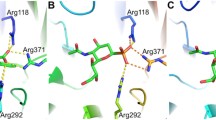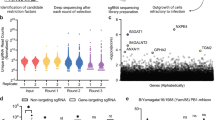Abstract
3-O-sulfation synthesizes sulfatide in the galactose moiety of galactosylceramide. Sulfatide is expressed in many organs such as the gastrointestinal tract, trachea, kidney, and central nervous system. Influenza A virus binds not only to glycoconjugates terminally containing sialic acid as a viral binding receptor but also to sulfatide not containing sialic acid. On the surface of infected cells, the envelope glycoprotein hemagglutinin of influenza A virus interacts with sulfatide. This interaction enhances the nuclear export of viral ribonucleoprotein complexes, resulting in efficient progeny viruses. Inhibiting this interaction would be a new potent anti-influenza drug that suppresses the progeny virus production in the infected cells.
Access this chapter
Tax calculation will be finalised at checkout
Purchases are for personal use only
Similar content being viewed by others
References
Suzuki Y (2005) Sialobiology of influenza: molecular mechanism of host range variation of influenza viruses. Biol Pharm Bull 28:399–408. https://doi.org/10.1248/bpb.28.399
Suzuki T, Sometani A, Yamazaki Y et al (1996) Sulphatide binds to human and animal influenza A viruses, and inhibits the viral infection. Biochem J 318:389–393. https://doi.org/10.1042/bj3180389
Takahashi T, Suzuki T (2012) Role of sulfatide in normal and pathological cells and tissues. J Lipid Res 53:1437–1450. https://doi.org/10.1194/jlr.R026682
Takahashi T, Satoh H, Takaguchi M et al (2010) Binding of sulphatide to recombinant haemagglutinin of influenza A virus produced by a baculovirus protein expression system. J Biochem 147:459–462. https://doi.org/10.1093/jb/mvq013
Takahashi T, Kawagishi S, Masuda M et al (2013) Binding kinetics of sulfatide with influenza A virus hemagglutinin. Glycoconj J 30:709–716. https://doi.org/10.1007/s10719-013-9477-7
Takahashi T, Murakami K, Nagakura M et al (2008) Sulfatide is required for efficient replication of influenza A virus. J Virol 82:5940–5950. https://doi.org/10.1128/JVI.02496-07
Ogura K, Kohno K, Tai T (2002) Molecular cloning of a rat brain cDNA, with homology to a tyrosine kinase substrate, that induces galactosylceramide expression in COS-7 cells. J Neurochem 71:1827–1836. https://doi.org/10.1046/j.1471-4159.1998.71051827.x
Wurzer WJ, Planz O, Ehrhardt C et al (2003) Caspase 3 activation is essential for efficient influenza virus propagation. EMBO J 22:2717–2728. https://doi.org/10.1093/emboj/cdg279
Daugas E, Susin SA, Zamzami N et al (2000) Mitochondrio-nuclear translocation of AIF in apoptosis and necrosis. FASEB J 14:729–739. https://doi.org/10.1096/fasebj.14.5.729
Chen W, Calvo PA, Malide D et al (2001) A novel influenza A virus mitochondrial protein that induces cell death. Nat Med 7:1306–1312. https://doi.org/10.1038/nm1201-1306
Marjuki H, Alam MI, Ehrhardt C et al (2006) Membrane accumulation of influenza A virus hemagglutinin triggers nuclear export of the viral genome via protein kinase Cα-mediated activation of ERK signaling. J Biol Chem 281:16707–16715. https://doi.org/10.1074/jbc.M510233200
Schreiber A, Boff L, Anhlan D et al (2020) Dissecting the mechanism of signaling-triggered nuclear export of newly synthesized influenza virus ribonucleoprotein complexes. Proc Natl Acad Sci U S A 117:16557–16566. https://doi.org/10.1073/pnas.2002828117
Falerio L, Lazebnik Y (2000) Caspases disrupt the nuclear-cytoplasmic barrier. J Cell Biol 151:951–959. https://doi.org/10.1083/jcb.151.5.951
Takahashi T, Takaguchi M, Kawakami T et al (2013) Sulfatide regulates caspase-3-independent apoptosis of influenza A virus through viral PB1-F2 protein. PLoS One 8:e61092. https://doi.org/10.1371/journal.pone.0061092
Takahashi T, Suzuki T (2015) Role of sulfatide in influenza A virus replication. Biol Pharm Bull 38:809–816. https://doi.org/10.1248/bpb.b15-00119
Takahashi T, Moriyama Y, Ikari A et al (2008) Surface localization of the nuclear receptor CAR in influenza A virus-infected cells. Biochem Biophys Res Commun 368:550–555. https://doi.org/10.1016/j.bbrc.2008.01.145
Arora DJ, Tremblay P, Bourgault R et al (1985) Concentration and purification of influenza virus from allantoic fluid. Anal Biochem 144:189–192. https://doi.org/10.1016/0003-2697(85)90103-4
Ding Z, Kawashima Y, Suzuki Y et al (1997) A sulfatide receptor distinct from L-selectin is involved in lymphocyte activation. FEBS Lett 418:310–314. https://doi.org/10.1016/S0014-5793(97)01400-2
Shikata K, Suzuki Y, Wada J et al (1999) L-selectin and its ligands mediate infiltration of mononuclear cells into kidney interstitium after ureteric obstruction. J Pathol 188:93–99. https://doi.org/10.1002/(SICI)1096-9896(199905)188:1<93::AID-PATH305>3.0.CO;2-#
Neumann G, Watanabe T, Ito H et al (1999) Generation of influenza A viruses entirely from cloned cDNAs. Proc Natl Acad Sci U S A 96:9345–9350. https://doi.org/10.1073/pnas.96.16.9345
Acknowledgments
This work was supported by JSPS KAKENHI Grant numbers, Young Scientists (B) JP20790357, Scientific Research (C) JP23590549, Young Scientists (A) JP15H05644, Scientific Research (B) JP21H03183, and Challenging Exploratory Research JP26670064, JP16K15151, and JP20K21721. This work was partially supported by grants-in-aid from Takeda Science Foundation, Yakurikigakukenkyukai, Tokyo Biochemical Research Foundation, Hamamatsu Scientific Research Foundation, The Research Foundation for Pharmaceutical Sciences, The Public Foundation of Chubu, Science and Technology Center, The Waksman Foundation of Japan Inc., Showa University Medical Foundation, The Uehara Memorial Foundation, The Japan Science Society (20–403), Mizutani Foundation for Glycoscience, Foundation for Promotion of Material Science and Technology of Japan, Adaptable and Seamless Technology Transfer Program through Target-driven R&D (A-STEP) from Japan Science and Technology Agency, CREST from Japan Science and Technology Agency, and the Global COE Program from the Japan Society for the Promotion of Science.
Author information
Authors and Affiliations
Corresponding author
Editor information
Editors and Affiliations
Rights and permissions
Copyright information
© 2022 The Author(s), under exclusive license to Springer Science+Business Media, LLC, part of Springer Nature
About this protocol
Cite this protocol
Takahashi, T., Kurebayashi, Y., Suzuki, T. (2022). Functional Analysis of Sulfatide in Influenza A Virus Infection and Replication. In: Suzuki, Y. (eds) Glycovirology. Methods in Molecular Biology, vol 2556. Humana, New York, NY. https://doi.org/10.1007/978-1-0716-2635-1_9
Download citation
DOI: https://doi.org/10.1007/978-1-0716-2635-1_9
Published:
Publisher Name: Humana, New York, NY
Print ISBN: 978-1-0716-2634-4
Online ISBN: 978-1-0716-2635-1
eBook Packages: Springer Protocols




